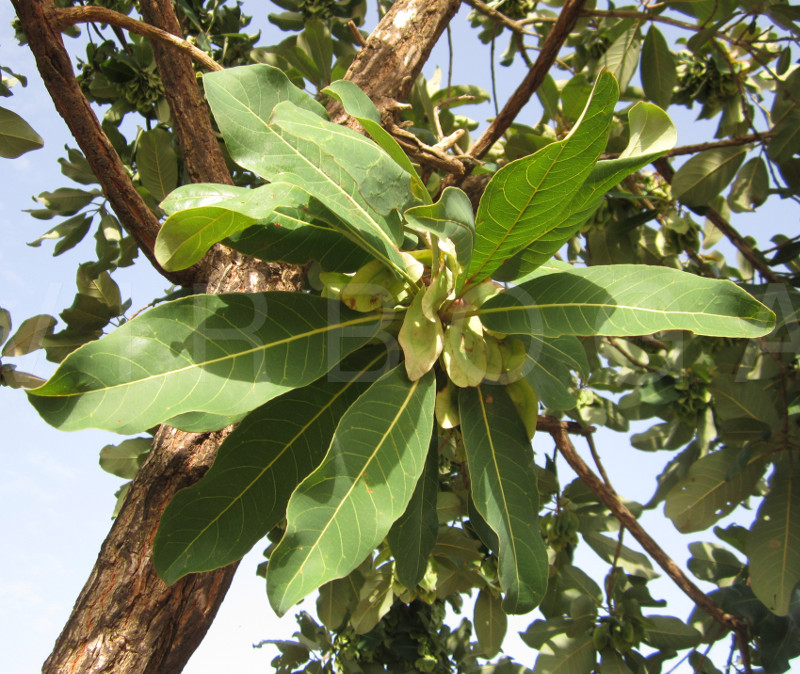Terminalia schimperiana

|
|
Terminalia schimperiana Common Names: Tult, Idi Odan, African Silver
Terminalia Scientific
Classification Kingdom: Plantae Phylum: Tracheophyta Class: Magnoliopsida Order: Myrtales Family: Combretaceae Genus: Terminalia Species: T. schimperiana Synonyms: Terminalia glaucescens Planch. ex Benth., Terminalia togoensis Engl. & Diels, Terminalia baumanii Engl. & Diels, Terminalia passargei Engl. in Engl. & Diels, Terminalia longipes Engl. Description Terminalia schimperiana is a small to medium-sized deciduous tree, typically growing
7–14 m tall, occasionally reaching 20 m in favorable conditions. Its key
features include: · Bark: Grey to dark brown, fissured, often peeling in strips · Leaves: Broad, elliptic to obovate, 9–15 cm long, 3–8 cm wide, green
above with pale, hairy undersides · Flowers: Small, white, 3–5 mm in diameter, arranged in pale axillary
spikes 5–10 cm long, blooming during the rainy season · Fruit: Single-winged samara, 4–6 cm long, green turning brown when mature,
containing one seed
Distribution and Habitat Terminalia schimperiana is native to tropical Africa, ranging from Guinea and Sierra
Leone eastward to Uganda, Ethiopia, and South Sudan. It thrives in: · Ecosystems: Open forests, closed forest canopies, dry savannas, riverine
woodlands, and gallery forests · Climate: Tropical, with annual rainfall of 1,300–2,500 mm and
temperatures of 20–35°C · Soils: Well-drained, loamy to sandy, often along riverbanks or in
seasonally moist areas · Altitude: 100–2,000 m Ethnopharmacology Terminalia schimperiana is highly valued in West African traditional medicine, with
ethnopharmacological studies supporting its applications: · Antibacterial: In Nigeria, ethanol bark extracts inhibited Staphylococcus aureus (MIC 0.058 mg/mL) and Pseudomonas aeruginosa (MIC 0.5 mg/mL), supporting its use for
wound healing (Akande & Hayashi, 1998). · Antifungal: In Ghana, leaf extracts showed anti fungal activity · Anti-inflammatory: its use for swelling. · Oral Hygiene: In Sierra Leone, twig decoctions promoted gum health.. · Antimalarial: In Uganda, leaf extracts exhibited antiplasmodial activity
against Plasmodium falciparum (IC₅₀ 10–50 µg/mL), aligning with its traditional use for
fever (Bickii et al., 2007). ⚠ Toxicity Profile: No significant human toxicity is reported
for Terminalia schimperiana. Subacute toxicity studies in rats showed no adverse effects on
liver or kidney function at doses up to 3,000 mg/kg. However, excessive or
prolonged use may cause mild gastrointestinal discomfort due to high tannin
content. Adherence to traditional dosages is recommended (Awotunde et al.,
2019). Additional Uses · Industrial: Bark yields tannins for dyeing leather and fabrics,
producing rich brown hues. · Construction: The durable wood is used for paper pulp, rope-making, and
crafting tools. · Ecological: Provides shade, stabilizes soil along riverbanks, and
supports wildlife with its fruit, attracting birds and small mammals. · Cultural: In Yoruba communities, the tree is used in rituals for
healing and protection. References
External Links More Pictures |
|
| Compounds of Terminalia schimperiana | |
| References |